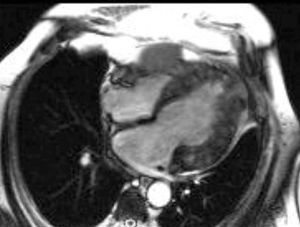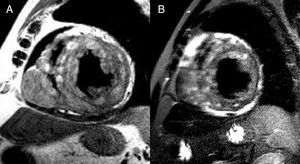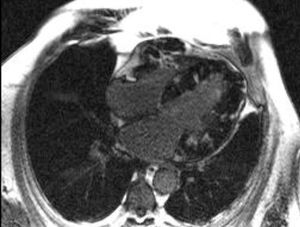A 62-year-old man underwent a left upper pulmonary segmentectomy following serendipitous detection of a solitary pulmonary nodule. The histological study showed a mesenchymal tumor with a morphological and immunohistochemical (positive for protein S-100) profile consistent with a diagnosis of melanotic schwannoma; the low mitotic index indicated a benign pattern. Later examinations excluded metastatic disease from melanoma of the skin or mucosa, choroids, or internal organs. Two years later, a follow-up chest computed tomography scan showed a lesion in the right ventricle, and the patient was referred to the cardiology department.
The patient was asymptomatic. Echocardiography provided limited information because of a poor acoustic window. Cardiac magnetic resonance imaging showed left ventricular dilation with severe systolic dysfunction. The right ventricular free wall presented a 30x40-mm lesion. The wall of the left ventricle was infiltrated by small lesions (Figure 1) that were hyperintense on gradient-echo sequences and T1- and T2-weighted images (Figure 2A); application of a fat-suppression pulse did not reduce the intensity of the signal (Figure 2B). Areas of late gadolinium uptake were observed in both ventricles (Figure 3). Endomyocardial biopsy did not provide diagnostic data because the lesions had not infiltrated the subendocardium. At 1 year following the diagnosis, the patient remained asymptomatic and was receiving angiotensin-converting enzyme inhibitors.
Figure 1.
Figure 2.
Figure 3.
Although a histopathological diagnosis was not available, the magnetic resonance pattern was typical of melanotic tumors. Schwannomas are tumors of neural origin rarely found in the heart. Although surgical treatment has been reported for local forms, the usual management approach is conservative. In melanotic forms, a differential diagnosis should be established with metastasis of melanoma.






